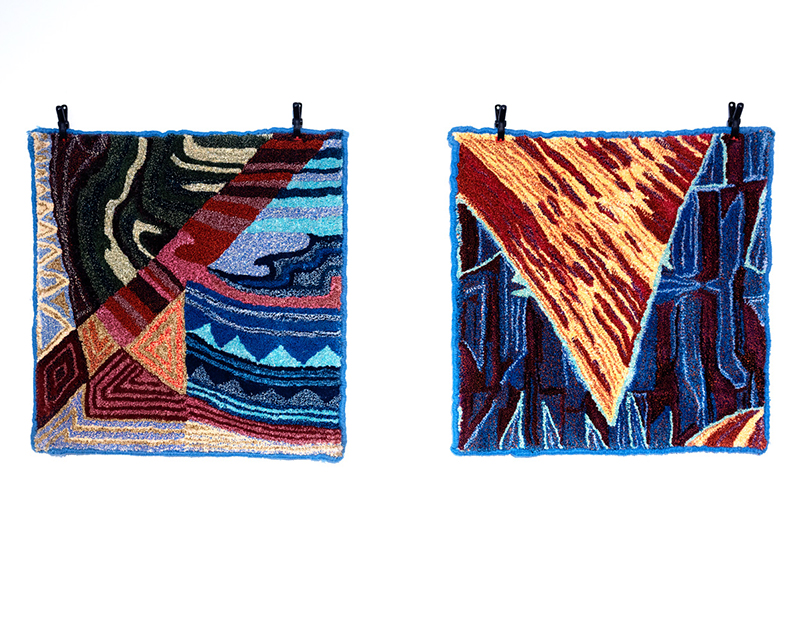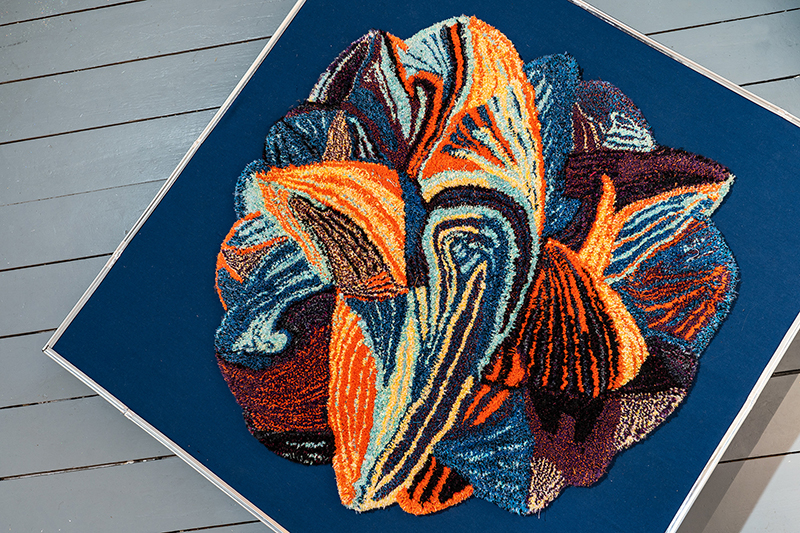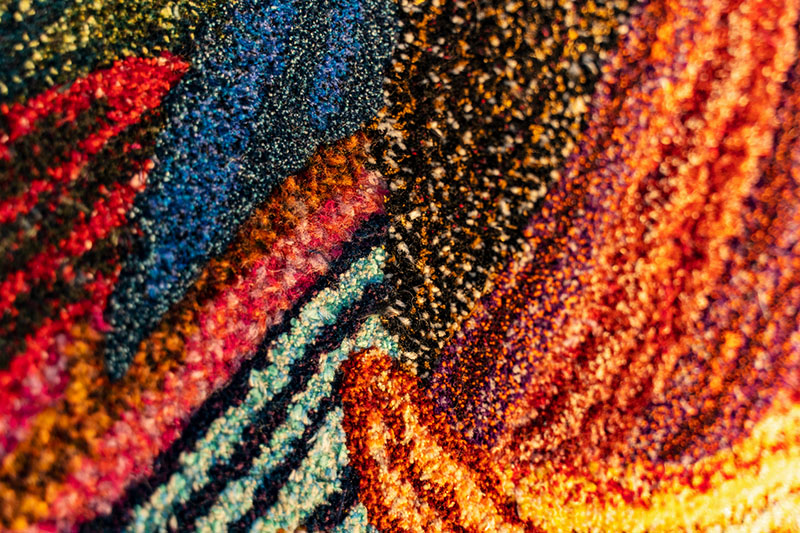by Dagmara Genda // June 3, 2022
Malte Spindler is actually a photographer and designer rather than “artist” per se, though these labels are perfunctory at best. Nevertheless, a little bit of labelling might put his current show at Lady Liberty Library and Showroom, a small nook in the entrance gate of ACUD, into better focus. This is because the works, and space itself, play with the limits of definitions and mediums in an effort to chart new conceptual and aesthetic territory. The showroom is run by Nina Prader, who is an art worker specialising in artist books and zine culture, and who seems to understand her whole practice through this lens. This is presumably why she enthusiastically exclaimed that the works in Spindler’s solo show, ‘Cosmologic Landscapes,’ could be understood as books. Her remark gave me pause, because what I saw before me were clearly rugs. Spindler’s plush woolly creations are, except for two earlier works on show, fanciful depictions of asteroids and exoplanets made of hand-dyed wool tufted into pseudo-psychedelic, sometimes 80s-like patterns. They lie on the floor, hang on the walls, and generally give the small space, which in itself has a casual living-room-like feel, a warm homey ambiance. Though at the time I expressed scepticism, Prader’s idiosyncratic statement stayed with me and in the end caused me to realise that this show, and the showroom too, should be understood as one strand in the fabric making up the DIY publishing scene.

Malte Spindler: installation view from ‘Cosmologic Landscapes’ at Lady Liberty Library and Showroom // Photo courtesy of Omri Livne and Lady Liberty Library
Though their roles are now artist and curator, Spindler, who is most often a designer of books, and Prader have worked together in other capacities before. Since 2020, they have been involved in the organisation of Indiecon Publishing Festival, a yearly three-day event at Hamburg’s Oberhafen that will take place in September this year. As two members of a larger artistic collective, they designed and organised ‘The Impossible Library’ (2020-2021), which, in the spirit of rugs being books, was, according to the website, “not a library.” Instead it was a workshop whose tools were “over 1000 independent magazines and zines” that “investigate[ed] the relation between subversive publishing and society.” Judging from her website, it seems that Prader conceives of her curatorial practice as publishing, and shows are seen as libraries. It follows that she must have a somewhat idiosyncratic view of reading. Among the selection of books that Spindler and Prader publish, both separately and together, are books without words as well as books that are made using the now seemingly antiquated risograph technology, a mechanical process of printing that, in a method similar to silkscreen, layers colours atop one another to create different tones. The resulting prints have a vintage quality to them. The layers might not align perfectly and the colours are not always even. The tones of the colours themselves elicit a vague nostalgia. This is all to say that the books that Spindler and Prader publish are just as haptic and visual as they are textual, if not more so.
So what sort of haptic or visual story do Spindler’s woolly asteroids and exoplanets tell? The work ‘8 Flora’ (2021), for example, is also the name of an asteroid discovered by J.R. Hind in 1847, though in Spindler’s hands, it becomes a stylized design translated into an irregularly shaped carpet. First he makes a small drawing of the asteroid, then projects it on the backing cloth for the rug, traces and tufts. The exoplanets, on the other hand, are inventions. They are part of an internet phenomenon where artists try to visualise planets outside our solar system. It is, however, not the process of imagining distant worlds which can necessarily be read into his work—translated into rugs the patterns look more like funky sweaters your grandma made than extraterrestrial rocks—but the process of handwork that went into them. Spindler uses a hand-tufting machine, which, like a sewing machine, consists of one needle that automatically cuts the yarn as he works. He discovered the technique during the series of pandemic-induced lockdowns over the past few years. Stuck in his home, he became part of a vibrant internet community of tufters who try to outcompete each other with prodigiously large carpets of marvel action heroes or Pokémon characters.

Malte Spindler: installation view from ‘Cosmologic Landscapes’ at Lady Liberty Library and Showroom // Photo courtesy of Malte Spindler and Lady Liberty Library

Malte Spindler: detail of ‘141 lumen’ (2021) // Photo courtesy of Malte Spindler and Lady Liberty Library
I would claim that more important than the content, is Spindler’s relationship to the rugs’ materiality and production process. The books Spindler publishes, both his own and that of other artists, are intended to be read with the hands as well as the eyes—through the experience of texture, paper size and weight, feel of the ink, etc. This is the same way one experiences his rugs, which the artist encourages the “viewer” to touch. The process of making is also on display. In front of the window is a little “museum” where his tools and carpet samples are presented. What Spindler is asking the viewer to contemplate is not just the object he makes, but also the means of production that go into all our everyday objects. Handwork and personal investment is elevated to the level of “art,” combining usefulness with, through specific content and formal decisions, aesthetic reflection.
Employing contemplative perception in the experience of everyday objects is a part of what Prader’s Showroom and Library is about. She offers visitors filter coffee and invites them to sit down and “read” from her eclectic collection of zines, independent magazines, picture books, artist books and comics. She helpfully points out the different ways the books were made, how certain colours were achieved, how particular visual effects were produced, while also explaining the content and history of each book. In effect, she teaches the viewer to read a different type of language—the embodied language of artefacts and materiality rather than the semiotic system of words. In Spindler’s case, the act of tufting, which is the threading of wool through a screen to create an image, is parallel to risograph printing, which squeezes ink through holes in a cylinder to make a picture; the final image formed is a direct consequence of its material production, rather than a slick representation that silences the medium in favour of content. In this way Prader and Spindler make art physically accessible and, by literally making them touchable, bring concepts of labour and production closer to the visitor. Accessibility is further reflected in the prices of books and rugs. Though not always cheap, they are not intended for the luxury market. Instead they invite a slower, more contemplative approach to material culture and our environment in general.
Exhibition Info
Lady Liberty Library and Showroom
Malte Spindler
Exhibition: May 1–June 30, 2022, open by appointment
ladylibertypress.org
Veteranenstrasse 21, Passageway of ACUD MACHT NEU, click here for map



















